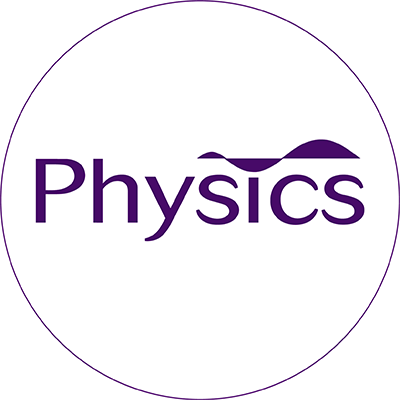
Physics Magazine
@PhysicsMagazine
Followers
74K
Following
2K
Media
1K
Statuses
7K
Reporting physics research advances. Also https://t.co/xpdUZRYzEB & https://t.co/x53DCGecVz
Ridge, NY
Joined November 2011
Quantum networks that rely on entangled photons reduce transmission errors by having receiving nodes send a signal, called a herald, each time an entangled photon arrives. New research finds that producing heralds at sending nodes reduces errors further. https://t.co/KhWw33G2yr
0
21
71
Researchers have succeeded in laser cooling and trapping aluminum fluoride molecules. The feat takes physicists a step closer to cooling AlF molecules into a Bose-Einstein condensate. https://t.co/vI4nf0qSFJ
0
17
69
🥚 Effortless Eggshell Opening! Crack eggs like a pro with the Egg Shell Opener! Perfect for soft or hard-boiled eggs, this handy tool makes breakfast easier than ever.
61
336
3K
A survey conducted by the UK’s Institute of Physics Publishing found that 41% of its authors and referees thought generative AI had an overall positive impact on peer review, while 37% thought the overall impact was negative. https://t.co/47tLsaL2et
0
1
10
A new fluid-control valve inspired by the way strong wind flaps an umbrella inside out could find uses in wearable devices, microfluidics, and soft robotics. https://t.co/ZeZ6URgYPB
2
16
52
Researchers have devised a “reset or reload” protocol that mitigates the loss of atoms from devices that use cold, trapped atoms for quantum computing. The method held up through 41 successive operations. https://t.co/R4jTVivtyw
0
21
91
At Maverik, we take being Adventure’s First Stop seriously. We’ve got you covered for all your fuel, food and drink needs!
0
3
23
The Higgs field hides electroweak symmetry and gives masses to the electroweak bosons, W and Z. New results from the ATLAS Collaboration support the idea that the quark and charged-lepton masses are also the work of the Higgs field. https://t.co/YbyAuxfmWd
3
22
64
In 1927 Einstein devised a thought experiment to expose what he believed was contradictory character of quantum complementarity. Researchers have now performed the experiment in a way that could explore other, less established aspects of quantum mechanics. https://t.co/WKQmY810hz
0
5
28
Within femtoseconds, a photon absorbed by a molecule can cause electrons to jump between energy levels, atoms to vibrate, and chemical bonds to rearrange. Now researchers have shown that ultrafast electron diffraction can track those perturbations. https://t.co/70W0wpSZAk
0
5
13
The fractional quantum Hall effect comes with fractionally charged quasiparticles called anyons. Curiously, anyon charges are found to be multiples of their expected values. Now theorists have a solution: anyons bind together into “molecules.” https://t.co/DKKJiZ9A4b
0
3
13
The coming years will split companies into two groups: those that become AI-native and those left catching up. The innovators who harness AI now will define the winners of tomorrow. Follow me for strategic insights on leading through the AI revolution.
11
14
130
Two independent groups have proposed a new class of 2D multiferroic materials that could find applications in spin-based computers, sensors, and energy-harvesting devices. https://t.co/lWEER1LsiH
0
2
10
Surprisingly, the size distributions of shattered fragments follow a simple power law. Now researchers have shown that the statistical regularities of fragmentation can emerge from a combination of maximum randomness and kinematic constraints. https://t.co/XQk10M88RW
0
0
6
Researchers have trapped molecules in the standing wave created by a laser field in a cavity. By mitigating Doppler broadening, the technique enhances high-precision molecular spectroscopy, which is used to search for new physics. https://t.co/8S42ys4iKZ
1
0
6
Devised 40 years ago, the Leggett-Garg inequality tests whether a system’s evolution can be described by classical realism. Now researchers have shown that this limit can be surpassed by a quantum system evolving under a superposition of operations. https://t.co/OsSmWONfSG
0
0
5
Add festive style to your kitchen — these natural wood trivets keep hot cookware off your table safely.
0
0
9
Researchers have imaged and stretched a gold nanowire while also tracking its electrical conductance. The two-for-one experiment enabled them to pinpoint the width at which ballistic transport becomes operative. https://t.co/q56agC3661
2
1
10
Researchers have placed a precise amount of charge on a microparticle trapped in optical tweezers. Their technique could lead to better understanding of the effects of charged particles on lightning and clouds. https://t.co/Z7OpjqFjDB
1
2
7
Researchers have built and studied a tiny engine in the form of a levitated glass microparticle. The engine’s counterintuitive thermodynamics may help explain the nonequilibrium behavior of various biological systems. https://t.co/Qwmbjq9BWZ
0
0
5
Researchers have analyzed a hypothetical scenario in which three Cooper pairs tunnel simultaneously in a four-terminal Josephson junction. Such a process is important because it could facilitate new functionalities in quantum technologies. https://t.co/zKxwdTEN6t
0
1
10
The city was broke—but not broken. Drop Dead City, the 2025 documentary about NYC’s 1975 fiscal crisis, is out now. Don’t miss this smart, gripping and unexpectedly poignant story of urban survival, now streaming on all major platforms!
0
86
627
The extent of a particle’s wave function depends on the particle’s mass and environment. Researchers have developed an optical method that sheds light on this dependence for single H2 and D2 molecules trapped in a superfluid helium nanodroplet. https://t.co/JZXHqep0vT
1
4
10
Researchers have determined the entropy of a double quantum dot by measuring how much energy is needed to pack in an additional electron. Their method could be used to determine quantities that are harder to measure, such as exotic quasiparticle couplings. https://t.co/iGkIxS3yHM
4
1
9
Quantum magic is a property of certain quantum states that enables operations outside the fault-tolerant, classically accessible set. Last year two theorists answered the long-standing question of how to reliably measure this important property. https://t.co/yLN37EN6FQ
0
0
3





